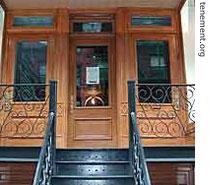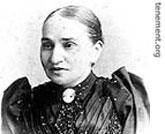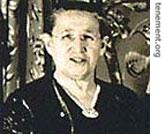VOA慢速英语 2008 0326b
搜索关注在线英语听力室公众号:tingroom,领取免费英语资料大礼包。
(单词翻译)
EXPLORATIONS - Tenement1 Museum Recreates Old Immigrant2 Life in New York City
A visit to the apartments of the Gumpertz family, the Baldizzis, the Rogarshevskys, the Levines and the Confinos. Transcript3 of radio broadcast:
25 March 2008
VOICE ONE:
I’m Gwen Outen.
VOICE TWO:
And I’m Steve Ember with EXPLORATIONS in VOA Special English. Today, we tell about a museum in New York City. It explores and celebrates the stories of people from different nations who came to the United States to live.
(MUSIC)
VOICE ONE:
 |
| The front of 97 Orchard4 Street |
The Lower East Side Tenement Museum is one of the smaller museums in New York City. It lets visitors experience how early immigrants5 to the United States lived. The museum is a building at Ninety-Seven Orchard Street. It was built in eighteen sixty-three. It was one of the first tenements6 in New York City.
The word “tenement” comes from a Latin7 word meaning “to hold.” A tenement building holds many rooms where different families lived.
The word is not used much anymore in the United States. When people use the word today, they mean an old crowded building where poor families live in terrible, unhealthy conditions. But in the eighteen hundreds, the word “tenement” simply meant a building in which many families lived.
Later, many immigrant families improved their living conditions by moving from the lower east side to other areas of New York City. Some lived in the same kinds of buildings, but the living areas were cleaner and larger. They did not want to call them tenements, so they called them apartment buildings instead.
VOICE TWO:
History experts say more than half the people in New York City lived in tenements in eighteen sixty-three. To get one of these living areas, a family had to pay one month’s rent to the owner, usually about ten dollars. This money gave the family the use of about one hundred square meters of living space, often divided into three rooms.
The building at Ninety-Seven Orchard Street shows the kind of spaces where families lived. The front room was the largest. It was the only one with a window. Behind it were a kitchen for cooking and a small bedroom for sleeping. The apartment had no running water, no bathroom, toilet or shower. There were six places where people left their body wastes in the back yard, next to the only place to get drinking water. Such unhealthy conditions led to the spread of disease8.
Over the years, New York City officials passed laws to improve conditions in the tenements. The owners of Ninety-Seven Orchard Street placed gas lighting9 in the building in the eighteen nineties. They added water and indoor toilets in nineteen-oh-five, and electric power in nineteen twenty-four. Then they refused to make any more improvements10. They closed the building in nineteen thirty-five.
In nineteen ninety-eight, the federal11 government declared the building a protected National Historic12 Place.
VOICE ONE:
Museum officials researched the history of the building and its twenty apartments. They found more than one thousand objects that belonged to people who lived there. These include kitchen devices13, medicine bottles, letters, newspapers, money and pieces of cloth. They also learned14 the histories of many of the seven thousand people from more than twenty countries who lived there. And they spoke15 with and recorded memories of people who lived at Ninety-Seven Orchard Street as children.
Museum officials used this information to re-create some of the apartments as they would have looked during different time periods in the building’s history. These apartments are what people see when they visit the Lower East Side Tenement Museum. Let us join one of the guided visits. First we climb several flights of worn stairs. It is a very hot day and we feel the heat in the dark, narrow hallway.
(MUSIC)
VOICE TWO:
Now we enter the apartment of the Gumpertz family. They were Jews from Germany who lived here in the eighteen seventies.
 |
| Nathalie Gumpertz |
On October seventh, eighteen seventy-four, Julius Gumpertz dressed for work, left the building and never returned. He left his wife Nathalie and their four children, ages eight months to seven years. Nathalie was forced to support her children by making clothing in the apartment. She earned about eight dollars a week, enough to pay for the apartment each month and send her children to school.
The Gumpertz apartment has a sewing machine and other tools similar to those Nathalie used in her work. She made the largest room into her workspace. That was where she saw people who wanted clothes made or repaired. It was also where she did the sewing.
VOICE ONE:
The next apartment we visit belonged to the Baldizzi family. They came from Italy and were Catholic16. Adolfo Baldizzi, his wife Rosaria and their two children moved to Orchard Street in nineteen twenty-eight. They became friends with other families in the building. Their daughter Josephine liked to help other people. Every Friday night she would turn on the lights in the nearby apartment of the Rosenthal family. The Rosenthals could not turn on the lights themselves because it was the start of the Jewish17 holy day and no work was permitted.
Josephine Baldizzi remembered those long ago days. Here is a recording18 of her. She tells how she felt each week after when she saw Missus Rosenthal in the window motioning19 for her to come and turn on the lights:
JOSEPHINE BALDIZZI:
"It made me very proud to have to do that. I used to feel good that she chose me to do that job for her. And I can still see her till today—the vision20 of her in that window. It has never left my memory."
(MUSIC)
VOICE TWO:
 |
| Fanny Rogarshevsky |
Now we visit the apartment that belonged to the Rogarshevsky family of Lithuania. They moved to Ninety-Seven Orchard Street between nineteen-oh-seven and nineteen ten. Abraham and Fannie Rogarshevsky had six children. Abraham developed the disease tuberculosis21. We can see some of the things used to fight the disease. But the efforts did not cure him. Abraham Rogarshevsky died in nineteen eighteen.
On the table we see the kinds of foods that family and friends would have eaten after Abraham’s funeral. They include hard-boiled eggs and round bread. Both represent the circle of life, from birth to death.
Fannie Rogarshevsky was faced with the same problem as Nathalie Gumpertz. What could she do to support her family and continue to live in the apartment? She got the building owner to let her clean apartments and do other work in exchange for rent.
VOICE ONE:
Now we enter the apartment of the Levine family. They were Jews from Poland. Jennie and Harris Levine moved into the building in the early eighteen nineties. They lived there for more than ten years. During that time, Jennie gave birth to four children. Her husband and his workers produced clothing in the front room.
We see Jennie in the bedroom awaiting22 the birth of her third child. We also see the clothing shop as it looked after the workers had gone home at the end of the day. We hear stories about the many immigrants who have worked in the clothing industry in New York City.
(MUSIC)
VOICE TWO:
Still another apartment is an example of living history. We can visit it on a special tour. It belonged to the Confino family in nineteen sixteen. Abraham and Rachel Confino came to New York from Turkey. They were Sephardic Jews, people whose ancestors had been born in Spain, North Africa or Middle Eastern countries.
An actress who plays thirteen-year-old Victoria Confino welcomes us. She tells about Victoria’s experience living in the building. Here, she explains the language of Sephardic Jews, called Ladino, and sings part of a sad Ladino song:
VICTORIA CONFINO:
“Oh, it’s a very mixed up language. It’s like a little bit Spanish...we call it Judeo Espagnol...and it’s a little bit Turkish, a little bit Hebrew...a lot of languages mixed up all together.”
VOICE ONE:
Officials say one of the purposes of the Lower East Side Tenement Museum is to use history to explore modern social issues. For example, what kinds of problems do recent immigrants face while trying to build new lives in America?
The Lower East Side Tenement Museum cooperates23 with other international historic places around the world. These places are part of the International Coalition24 of Historic Site Museums of Conscience25.
They include the District Six Museum in South Africa, the Gulag Museum in Russia, and Project To Remember in Argentina. Others are the Terezin Memorial in the Czech Republic, the Workhouse in England and the Slave House in Senegal. Officials of these historic places are working together to help explore and solve modern problems in their own societies.
(MUSIC)
VOICE TWO:
This program was written by Nancy Steinbach and produced by Mario Ritter. I’m Steve Ember.
VOICE ONE:
And I’m Gwen Outen. Join us again next week for EXPLORATIONS in VOA Special English.
 收听单词发音
收听单词发音 




